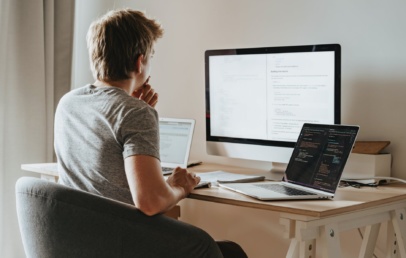If you’re not new to cryptocurrencies, you must have heard of the Binance Chain, the dwelling of BNB currency. Binance Smart Chain (BSC) is getting flooded by crypto activity, ranging from decentralized money markets to cute non-fungible tokens (NFTs) and token swaps.
Binance Chain is optimized for ultra-fast trading. To get such quick speed, the chain had to undergo certain trade-offs, making it not as flexible as other blockchains when it comes to a programmability standpoint.
Introduction to Binance Smart Chain (BSC)
Binance is one of the biggest crypto exchanges in the market, rivaling other famous exchanges such as FTX, Gemini, and Coinbase. It was initially an exchange, but they eventually built their own blockchain, which is fast and can manage a lot of data. The Binance Chain only has the Binance exchange as its center of focus.
After two years of launching their first blockchain, Binance then again launched another blockchain with smart contracts, called the Binance Smart Chain. Ethereum inspired the idea of having a smart contract, and the stellar team behind Binance decided to adapt it since they also see great potential with this innovative idea.
Smart contracts are used in building applications that operate on a blockchain. It allows the production of new tokens, mint NFTs and is necessary for any undertakings related to decentralized finance (DeFi).
Binance Smart Chain emerged from the forking of Ethereum’s code, enabling it to have the same features as Ethereum. At the same time, developers behind BSC made a few improvements that would make it cheaper and faster. In order to achieve fast and cheap transactions, BSM relinquishes its decentralization.
Since Binance Smart Chain was cracked from Ethereum’s code, developers can effortlessly pass their projects from the BSC to the Ethereum network without reworking so many codes.
Binance Chain versus Binance Smart Chain
Many people use Binance Chain and Binance Smart Chain interchangeably, thinking that both projects are just the same, which causes a big misunderstanding, especially to those new in the space.
The first and original blockchain that Binance has created is Binance Chain, while the one with employed smart contracts is Binance Smart Chain. Even though BSC is designed to run alongside the original Binance Chain, if a person gets confused and sends their money on Binance Smart Chain from Binance Chain or otherwise, the funds transferred can get lost.
Binance Smart Chain is an individual blockchain and not a replacement for the Binance Chain. It was developed to fix frustrating issues (e.g., programmability limitations) of the Binance Chain.
Binance Smart Chain is popular for having a dual-chain architecture that empowers users to build digital assets and decentralized applications, which cannot be undertaken on the Binance Chain.
Consensus Model of Binance Smart Chain
Binance Smart Chain (BSC) uses the consensus model of the delegated proof-of-stake (DPoS). The individuals who stake most BNB coins have the power to judge which activities should be verified and blocked.
If you’re not among those people who can afford to hold millions of dollars BNB, you can still earn some good rewards even with a small amount. To do this, you can delegate your coins to top validators, and they will share their rewards with you.
The consensus model that Binance Smart Chain uses is quite centralized, but its centrality is what allows the cheap and fast transactions within the blockchain.
A user can utilize Binance Smart Chain to make about 100 transactions without paying more than $1, which, compared to Ethereum, is way lower. An average transaction fee in the Ethereum network averages from $3 up to $50, and even much more expensive for smart contract usages.
Since just anyone can create their own token on the Binance blockchain for a very low price, malicious developers, frauds, and online criminals began springing up to the Binance Smart Chain network.
Among the projects that emerged from Binance Smart Chain is the decentralized token exchange called PancakeSwap, which allows one decentralized token to swap one token for another. Early users of the platform are able to make tokens from scratch and promote them on websites such as Reddit. However, numerous tokens from this are mere scams. Yet, because of the decentralized nature of crypto space, no one is held accountable for the fraud.
Aside from Binance Smart Chain, there are many blockchains that arose to beat Ethereum. There’s Polygon, to name one.
Tokenomics of BNB
BNB is Binance’s native coin, specially designed for utilization in the Binance ecosystem. Initially, there were about 200 million BNB coins minted. Binance sold half (100 million) of the minted coins in an Initial Coin Offering (ICO) back in July 2017 for $0.15 each. The ICO raised around $15 million.
Currently, BNB coins cost $400 each, and those who have invested a good amount in Binance back then surely got a good chunk of money in their pockets.
The coins that were given to the founding team were 40% (80 million) out of 200 million BNB, but only 20% of it was vested every year. And the remaining 10% (20 million) of the entire BNB coins go to angel investors.
Unlike other protocols, BNB is not inflationary, so there’s no block subsidy for every freshly minted BNB. On the other hand, Binance company buys its own tokens every three months using 20% of its profit to conduct coin burns.
The Binance team burn the tokens they buy, decreasing the overall supply and increasing the coin’s price. Coin burning will theoretically continue until the total number of coins reaches 100 million. The coin burn practice ensures that Binance coin supply remains finite, making it more valuable and scarcer.
Uses of BNB Coin
The functionality of the Binance Smart Chain greatly extends that of the original Binance chain, following a range of cutting-edge protocols that are designed to bridge the gap among different blockchains. Like other developing cryptocurrencies, the Binance coin (BNB) offers numerous uses, including:
- Low fees. When you use the Binance Exchange to trade BNB, you will be able to save quite a lot of trading fees. Binance decreases the already inexpensive trading fees by about 50% if you pay using the exchange native currency to trade. Hence, rather than paying $0.10 on a $100 transaction, you’d only pay $0.5 cents through BNB.
- Special offers and perks. You’ll have discount perks and special offers on marketplaces that have partnered with Binance if you pay through the BNB coin. Canva, a free graphic design platform, is among the platforms that accept BNB as payment. BNB holders can also book flights and hotels on selected websites, allowing cashless transactions. It also serves several purposes in the entertainment space, from buying lottery tickets to virtual gifts.
- Transfers and loans. On particular platforms, holders can use BNB as loan collateral, guaranteeing that the loan will eventually get paid. BNB coins also back some applications that allow users to pay friends and split bills.
Surely, there’s more to the Binance coin more than what it shows on the surface, and its uses extend beyond the Binance exchange, offering juicy rebates to incentivize users.
Although BNB is still in its infancy, its promise of staking alongside Ethereum Virtual Machine (EVM) compatibility allows the platform to be an ideal engine for developers to build a powerful decentralized application.



